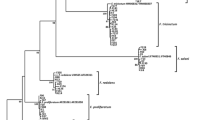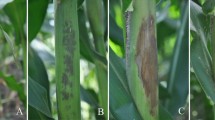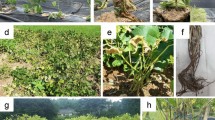Abstract
Soybean root rot is a worldwide soil-borne fungal disease threatening soybean production, causing large loss in yield and quality of soybean. Fusarium species are well recognized as the important causal agent of Fusarium root rot, which are often distinct with respect to various factors in different soybean-producing regions around the world. Recently, Fusarium root rot has been frequently reported in Sichuan Province of China, where is unique in its climate and diverse cropping patterns, but it is still unclear about the predominant Fusarium species and their pathogenicity on soybean. In this study, diseased soybean roots were collected from three regions of Sichuan Province during 2014–2015. Based on morphological characteristics and phylogenetic analysis of nucleotide sequences of the ribosomal internal transcribed spacer region and the translation elongation factor 1-α gene, 78 isolates of Fusarium were identified as nine distinct species. Pathogenicity tests showed that seven species of Fusarium were able to infect soybean, but differed in pathogenicity. F. oxysporum, F. equiseti and F. graminearum were the most aggressive species to soybean, whereas F. fujikuroi and F. verticillioides were not pathogenic to soybean. There was a strong positive correlation of the pathogenicity of Fusarium species with seedling emergence and fresh root weight. In addition, the diversity of Fusarium species varied among soybean-growing regions. To our knowledge, this report on population and pathogenicity of Fusarium species, in particular, F. graminearum, associated with soybean root rot in Sichuan Province of southwest China, will be helpful to provide effective control strategies for the disease.





Similar content being viewed by others
References
Backhouse, D. (2014). Global distribution of Fusarium graminearum, F. asiaticum and F. boothii from wheat in relation to climate. European Journal of Plant Pathology, 139, 161–173.
Barros, G. G., Zanon, M. S. A., Chiotta, M. L., Reynoso, M. M., Scandiani, M. M., & Chulze, S. N. (2014). Pathogenicity of phylogenetic species in the Fusarium graminearum complex on soybean seedlings in Argentina. European Journal of Plant Pathology, 138, 215–222.
Bateman, G. L., Gutteridge, R. J., Gherbawy, Y., Thomsett, M. A., & Nicholson, P. (2007). Infection of stem bases and grains of winter wheat by Fusarium culmorum and F. graminearum and effects of tillage method and maize-stalk residues. Plant Pathology, 56, 604e615.
Becher, R., Hettwer, U., Karlovsky, P., Deising, H. B., & Wirsel, S. G. (2010). Adaptation of Fusarium graminearum to tebuconazole yielded descendants diverging for levels of fitness, fungicide resistance, virulence, and mycotoxin production. Phytopathology, 100(5), 444.
Booth, C. (1971). The Genus Fusariμm. Kew: Commonwealth Mycological Institute.
Chang, K. F., Conner, R. L., Hwang, S. F., Ahmed, H. U., McLaren, D. L., Gossen, B. D., et al. (2014). Effects of seed treatments and inoculum density of Fusarium avenaceum and Rhizoctonia solani on seedling blight and root rot of faba bean. Canadian Journal of Plant Science, 94, 693–700.
Chang, K. F., Hwang, S. F., Conner, R. L., & Gossen, B. D. (2015). First report of Fusarium proliferatum causing root rot in soybean (Glycine max L.) in Canada. Crop Protection, 67, 52–58.
Costa, S. S., Matos, K. S., Tessmann, D. J., Seixas, C. D. S., & Pfenning, L. H. (2016). Fusarium paranaense sp. nov., a member of the Fusarium solani species complex causes root rot on soybean in Brazil. Fungal Biology, 120, 51–60.
Díaz Arias, M. M., Leandro, L., & Munkvold, G. (2013). Aggressiveness of Fusarium species and impact of root infection on growth and yield of soybean. Phytopathology, 103, 822–832.
Díaz Arias, M. M., Munkvold, G. P., & Leandro, L. F. (2011). First report of Fusarium proliferatum causing root rot on soybean (Glycine max) in the United States. Plant Disease, 95, 1316.
Ding, X. L., Zhang, B., Zhang, X. D., Yang, X. M., & Zhang, X. P. (2011). Effect of tillage and crop rotation on soil microbial residues in a rainfed agroecosystem of northest China. Soil & Tillage Research, 114, 43–49.
Doohan, F. M., Brennan, J., & Cooke, B. M. (2003). Influence of climatic factors on Fusarium species pathognic to cereals. European Journal of Plant Pathology, 109, 755–768.
Ellis, M. L., Díaz Arias, M. M., & Leandro, L. F. (2013). First report of Fusarium armeniacum causing seed rot and root rot on soybean (Glycine max) in the United States. Plant Disease, 97, 1557–1562.
Feng, J., Hwang, R., Chang, K. F., Hwang, S. F., Strelkov, S. E., Gossen, B. D., et al. (2010). Genetic variation in Fusarium avenaceum causing root rot on field pea. Plant Pathology, 59, 845–852.
Gao, X., Wu, M., Xu, R., Wang, X., Pan, R., Kim, Y., et al. (2014). Root interactions in a maize/soybean intercropping system control soybean soil-borne disease, Red Crown Rot. PLoS One, 9(5), e95031. https://doi.org/10.1371/journal.pone.0095031.
Geiser, D. M., Jiménez-Gasco, M. D. M., Kang, S., Makalowska, L., Veeraraghava, N., Ward, T. J., et al. (2004). Fusarium-ID v. 1.0: A DNA sequence database for identifying Fusarium. European Journal of Plant Pathology, 110, 473–479.
Harris, L. J., Balcerzak, M., Johnston, A., Schneiderman, D., & Ouellet, T. (2016). Host-preferential Fusarium graminearum gene expression during infection of wheat, barley and maize. Fungal Biology, 120, 111–123.
Hartman, G. L., Chang, H. X., & Leandro, L. F. (2015). Research advances and management of soybean sudden death syndrome. Crop Protection, 73, 60–66.
Hartman, G. L., Huang, Y. H., Nelson, R. L., & Noel, G. R. (1999). Germplasm evaluation of Glycine max for resistance to Fusarium solani, the causal organism of sudden death syndrome. Plant Disease, 81, 515–518.
Hartman, G. L., West, E. D., & Herman, T. K. (2011). Crops that feed the World 2. Soybean-worldwide production, use, and constraints caused by pathogens and pests. Food Security, 3, 5–17.
Kuhnem, P. R., Del Ponte, E. M., Dong, Y., & Bergstrom, G. C. (2015). Fusarium graminearum isolates from wheat and maize in New York show similar range of aggressiveness and toxigenicity in cross-species pathogenicity tests. Phytopathology, 105(4), 695–699.
Landschoot, S., Audenaert, K., Waegeman, W., Baets, B. D., & Haesaert, G. (2013). Influence of maize-wheat rotation systems on Fusarium head blight infection and deoxynivalenol content in wheat under low versus high disease pressure. Crop Protection, 52, 14–21.
Leslie, J. F., Anderson, L. L., Bowden, R. L., & Lee, Y. W. (2007). Inter- and intra- specific genetic variation in Fusarium. International Journal of Food Microbiology, 119, 25–32.
Leslie, J. F., Pearson, C. A. S., Nelson, P. E., & Toussoun, T. A. (1990). Fusarium spp. from corn, sorghum, soybean field in the central and eastern United States. Phytopathology, 80, 343–350.
Leslie, J. F., & Summerell, B. A. (2006). The Fusarium Laboratory Manual. UK: Blackwell Publish Ltd.
Nelson, B. D., Hansen, J. M., Windels, C. E., & Helms, T. C. (1997). Reaction of soybean cultivars to isolates of Fusarium solani from the Red River Valley. Plant Disease, 81, 664–668.
Niehaus, E. M., von Bargen, K. W., Espino, J. J., Humpf, H. U., & Tudzynski, B. (2014). Characterization of the fusaric acid gene cluster in Fusarium fujikuroi. Applied Microbiology and Biotechnology, 98(4), 1749–1762.
O’Donnell, K., Scandiani, M. M., Colletto, A. L. A., Biasoli, M., Lenzi, L., Salas, G., et al. (2010). Soybean sudden death syndrome species diversity within North and South America revealed by multilocus genotyping. Phytopathology, 100, 58–71.
O’Donnell, K., Ward, T. J., Robert, V. A. R., Crous, P. W., Geiser, D. W., & Kang, S. (2015). DNA sequence-based identification of Fusarium: Current status and future directions. Phytoparasitica, 43, 583–595.
Pioli, R. N., Mozzoni, L., & Morandi, E. N. (2004). First report of pathogenic association between Fusarium graminearum and soybean. Plant Disease, 88, 220.
Roy, K. W., Rupe, J. C., Hershman, D. E., & Abney, T. S. (1997). Sudden death syndrome of soybean. Plant Disease, 81, 1100–1111.
Sploti, P., Shah, D. A., Fernandes, J. M. C., Bergstrom, G. C., & Del Ponte, E. M. (2015). Disease risk, spatial patterns, and incidence-severity relationships of Fusarium head blight in no-till spring wheat following maize or soybean. Plant Disease, 99, 1360–1366.
Tamura, K., Peterson, D., Peterson, N., Stecher, G., Nei, M., & Kumar, S. (2011). MEGA5: molecular evolutionary genetics analysis using maximum likelihood, evolutionary distance, and maximum parsimony methods. Molecular Biology and Evolution, 28, 2731–2739.
Visentin, I., Valentino, D., Cardinale, F., & Tamietti, G. (2010). DNA-based tools for the detection of Fusarium spp. pathogenic on maize. In Y. Gherbawy & K. Voigt (Eds.), Molecular Identification of Fungi (pp. 107–129). Berlin Heidelberg: Springer.
Wang, X., & Wen, J. (2011). Species and pathogenicity of Fusarium causing soybean root rot in northeast China. Chinese Journal of Oil Crop Science, 33, 391–395.
Wei, W., Xu, Y. L., Zhu, L., Zhang, S. L., & Li, S. (2014). Impact of long-term continuous cropping on the Fusarium population in soybean rhizosphere. Chinese Journal of Applied Ecology, 25(2), 497–504.
West, J. S., Holdgate, S., Townsend, J. A., Edwards, S. G., Jennings, P., & Fitt, B. D. L. (2012). Impacts of changing climate and agronomic factors on fusarium ear blight of wheat in the UK. Fungal Ecology, 5, 53–61.
White, T. J., Bruns, T., & Lee, S. (1990). Analysis of phylogenetic relationships by amplification and direct seaquencing of ribosomal RNA genes. In M. A. Jnnis (Ed.), PCR Protocols: A Guide to Methods and Applications (pp. 15–22). New York: Academic.
Xue, A. G., Cober, E. R., Voldeng, H. D., Babcock, C., & Clear, R. M. (2007). Evaluation of the pathogenicity of Fusarium graminearum and Fusarium pseudograminearum on soybean seedlings under controlled conditions. Canadian Journal of Plant Pathology, 29, 35–40.
Yang, X. H., Gu, X., Zhao, H. L., Yao, L. L., Liu, W., Shen, H. B., et al. (2015). Investigation Report on Soybean Root Rot in Sanjiang Plain Area. Chinese Agricultural Science Bulletin, 31, 113–116.
Yang, F., Wang, X. C., Liao, D. P., Lu, F., Gao, R. C., Liu, W. G., et al. (2015). Yield response to different planting geometries in maize-soybean relay strip intercropping systems. Agronomy Journal, 107, 296–304.
Zhang, J. X., Xue, A. G., Zhang, H. J., Nagasawa, A. E., & Tambong, J. T. (2010). Response of soybean cultivars to root rot caused by Fusarium species. Canadian Journal of Plant Science, 90, 767–776.
Zhang, H. J., Xue, A. G., Zhang, J., Xu, Y., Yu, De. (2011). Biocontrol of soybean root rot caused by F. oxysporum and F. graminearum. Soybean Science, 30, 113–118.
Zhang, J. X., Xue, A. G., Cober, E. R., Morrison, M. J., Zhang, H. J., Zhang, S. Z., et al. (2013). Prevalence, pathogenicity and cultivar resistance of Fusarium and Rhizoctonia species causing soybean root rot. Canadian Journal of Plant Science, 93, 221–236.
Zhou, Q., Chen, Y., Yang, Y., Ahmed, H. U., Hwang, S. F., & Strelkov, S. E. (2014). Effect of inoculum density and quantitative PCR-based detection of Rhizoctonia solani AG-2-1 and Fusarium avenaceum on canola. Crop Protection, 59, 71–77.
Zhou, Y., & Gong, G. (2015). Identification of Botryosphaeriaceae species causing kiwifruit rot in Sichuan Province, China. Plant Disease, 99(5), 699–708.
Acknowledgments
This work was supported by the Key Science and Technology Support Project of Sichuan Province, China (Grant number: 2015NZ0040).
Author information
Authors and Affiliations
Corresponding author
Ethics declarations
Conflict of interest
There is no conflict of interest in this work.
All forms of financial support are acknowledged in the contribution. This work does not involve any human participants or animals. All authors have offered the consent to the submission.
Additional information
Xiaoli Chang and Hao Dai contribute equally to this work.
Electronic supplementary material
Table S1
Growth parameters and root rot severity (0–4 scale) of diseased soybean seedling inoculated with various Fusarium species for 7 days in a controlled environment (PDF 104 kb)
Fig. S1
Symptoms on soybean seedlings after 7 days inoculation with representative Fusarium isolates (PDF 326 kb)
Fig. S2
Growth situation of soybean seedlings after 20 days inoculation with representative Fusarium isolates (PDF 192 kb)
Rights and permissions
About this article
Cite this article
Chang, X., Dai, H., Wang, D. et al. Identification of Fusarium species associated with soybean root rot in Sichuan Province, China. Eur J Plant Pathol 151, 563–577 (2018). https://doi.org/10.1007/s10658-017-1410-7
Accepted:
Published:
Issue Date:
DOI: https://doi.org/10.1007/s10658-017-1410-7




